AMD Ryzen 5 3600 Review: Why Is This Amazon's Best Selling CPU?
by Dr. Ian Cutress on May 18, 2020 9:00 AM ESTCPU Performance: System Tests
Our System Test section focuses significantly on real-world testing, user experience, with a slight nod to throughput. In this section we cover application loading time, image processing, simple scientific physics, emulation, neural simulation, optimized compute, and 3D model development, with a combination of readily available and custom software. For some of these tests, the bigger suites such as PCMark do cover them (we publish those values in our office section), although multiple perspectives is always beneficial. In all our tests we will explain in-depth what is being tested, and how we are testing.
All of our benchmark results can also be found in our benchmark engine, Bench.
Application Load: GIMP 2.10.4
One of the most important aspects about user experience and workflow is how fast does a system respond. A good test of this is to see how long it takes for an application to load. Most applications these days, when on an SSD, load fairly instantly, however some office tools require asset pre-loading before being available. Most operating systems employ caching as well, so when certain software is loaded repeatedly (web browser, office tools), then can be initialized much quicker.
In our last suite, we tested how long it took to load a large PDF in Adobe Acrobat. Unfortunately this test was a nightmare to program for, and didn’t transfer over to Win10 RS3 easily. In the meantime we discovered an application that can automate this test, and we put it up against GIMP, a popular free open-source online photo editing tool, and the major alternative to Adobe Photoshop. We set it to load a large 50MB design template, and perform the load 10 times with 10 seconds in-between each. Due to caching, the first 3-5 results are often slower than the rest, and time to cache can be inconsistent, we take the average of the last five results to show CPU processing on cached loading.
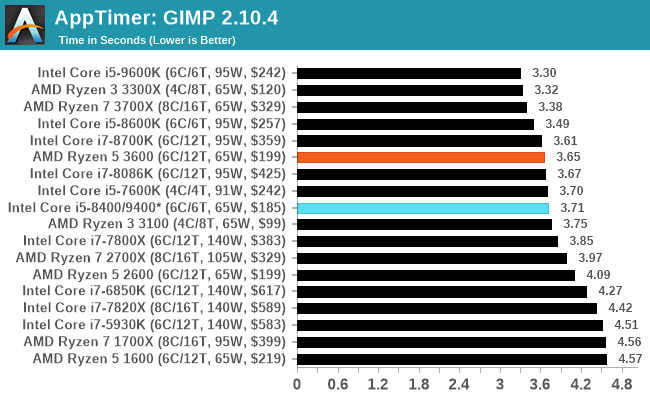
Not much difference here between the i5-8400 and the Ryzen 5 3600.
3D Particle Movement v2.1: Brownian Motion
Our 3DPM test is a custom built benchmark designed to simulate six different particle movement algorithms of points in a 3D space. The algorithms were developed as part of my PhD., and while ultimately perform best on a GPU, provide a good idea on how instruction streams are interpreted by different microarchitectures.
A key part of the algorithms is the random number generation – we use relatively fast generation which ends up implementing dependency chains in the code. The upgrade over the naïve first version of this code solved for false sharing in the caches, a major bottleneck. We are also looking at AVX2 and AVX512 versions of this benchmark for future reviews.
For this test, we run a stock particle set over the six algorithms for 20 seconds apiece, with 10 second pauses, and report the total rate of particle movement, in millions of operations (movements) per second. We have a non-AVX version and an AVX version, with the latter implementing AVX512 and AVX2 where possible.
3DPM v2.1 can be downloaded from our server: 3DPMv2.1.rar (13.0 MB)
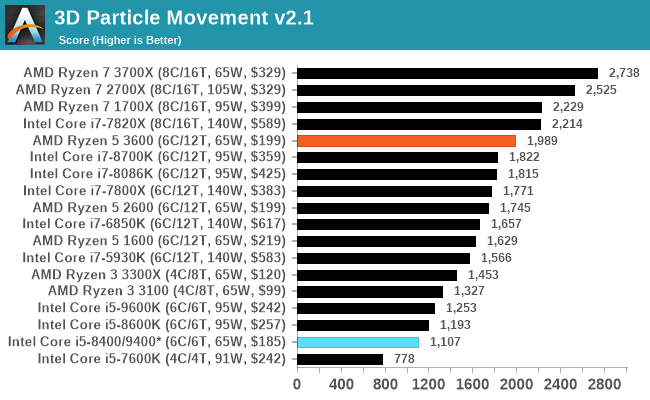
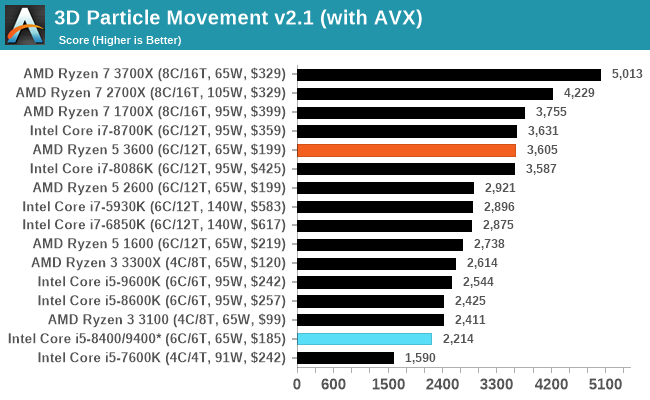
The core deficit comes on strong in 3DPM.
Dolphin 5.0: Console Emulation
One of the popular requested tests in our suite is to do with console emulation. Being able to pick up a game from an older system and run it as expected depends on the overhead of the emulator: it takes a significantly more powerful x86 system to be able to accurately emulate an older non-x86 console, especially if code for that console was made to abuse certain physical bugs in the hardware.
For our test, we use the popular Dolphin emulation software, and run a compute project through it to determine how close to a standard console system our processors can emulate. In this test, a Nintendo Wii would take around 1050 seconds.
The latest version of Dolphin can be downloaded from https://dolphin-emu.org/
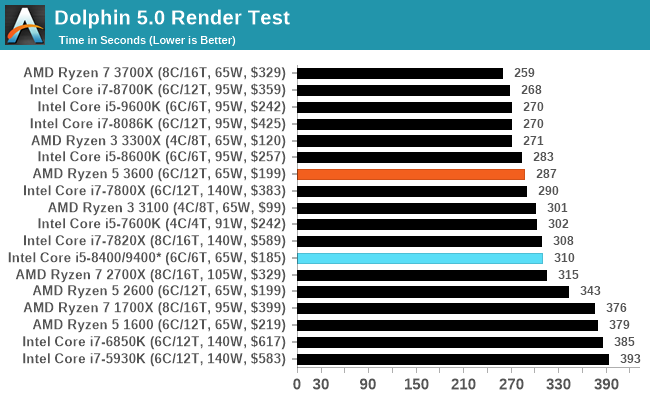
The Ryzen 5 3600 has better single threaded performance, and so the Dolphin emulation scores better with AMD.
DigiCortex 1.20: Sea Slug Brain Simulation
This benchmark was originally designed for simulation and visualization of neuron and synapse activity, as is commonly found in the brain. The software comes with a variety of benchmark modes, and we take the small benchmark which runs a 32k neuron / 1.8B synapse simulation, equivalent to a Sea Slug.
Example of a 2.1B neuron simulation
We report the results as the ability to simulate the data as a fraction of real-time, so anything above a ‘one’ is suitable for real-time work. Out of the two modes, a ‘non-firing’ mode which is DRAM heavy and a ‘firing’ mode which has CPU work, we choose the latter. Despite this, the benchmark is still affected by DRAM speed a fair amount.
DigiCortex can be downloaded from http://www.digicortex.net/
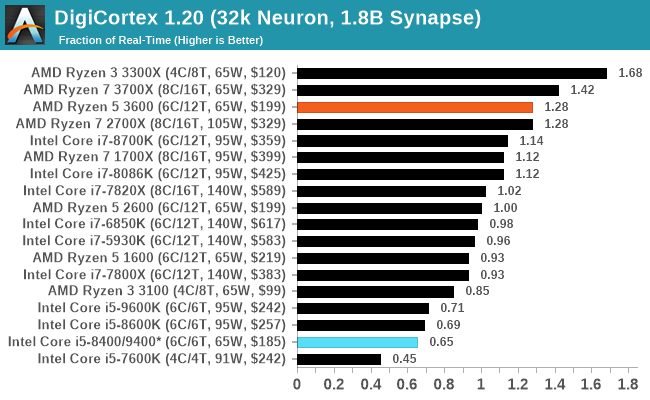
Dual DDR4-2666 doesn't mode well for the Intel processor.
y-Cruncher v0.7.6: Microarchitecture Optimized Compute
I’ve known about y-Cruncher for a while, as a tool to help compute various mathematical constants, but it wasn’t until I began talking with its developer, Alex Yee, a researcher from NWU and now software optimization developer, that I realized that he has optimized the software like crazy to get the best performance. Naturally, any simulation that can take 20+ days can benefit from a 1% performance increase! Alex started y-cruncher as a high-school project, but it is now at a state where Alex is keeping it up to date to take advantage of the latest instruction sets before they are even made available in hardware.
For our test we run y-cruncher v0.7.6 through all the different optimized variants of the binary, single threaded and multi-threaded, including the AVX-512 optimized binaries. The test is to calculate 250m digits of Pi, and we use the single threaded and multi-threaded versions of this test.
Users can download y-cruncher from Alex’s website: http://www.numberworld.org/y-cruncher/
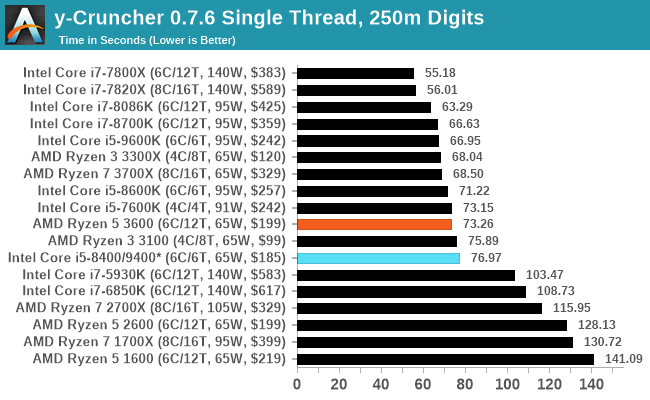

While almost similar in AVX2 in ST mode, the lack of threads again hurts the i5-8400, giving the win to the Ryzen 5 3600. Zen 2 does well here.
Agisoft Photoscan 1.3.3: 2D Image to 3D Model Conversion
One of the ISVs that we have worked with for a number of years is Agisoft, who develop software called PhotoScan that transforms a number of 2D images into a 3D model. This is an important tool in model development and archiving, and relies on a number of single threaded and multi-threaded algorithms to go from one side of the computation to the other.
In our test, we take v1.3.3 of the software with a good sized data set of 84 x 18 megapixel photos and push it through a reasonably fast variant of the algorithms, but is still more stringent than our 2017 test. We report the total time to complete the process.
Agisoft’s Photoscan website can be found here: http://www.agisoft.com/
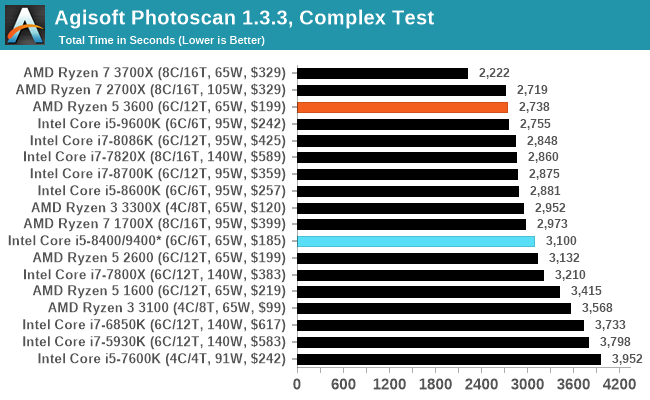












114 Comments
View All Comments
edzieba - Monday, May 18, 2020 - link
The "faster ram" columns always get a good laugh: anyone here running their DIMMs and /not/ using the XMP profiles?WaltC - Monday, May 18, 2020 - link
Right! What would be the point of that?...;) Intel isn't yet equal to AMD in architecture--still needs a bunch of vulnerability mitigation, and is still cranking out 14nm like there's no tomorrow...;) Intel's "high end" is in great demand, says Ian. Hmmm...I'll bet AMD's high end is even under higher demand--since Intel has very little if anything that can catch it. Zen 3 is going to fire another shot across Intel's bow...! Good times!PeachNCream - Monday, May 18, 2020 - link
Yeah, but how many desktop CPUs are getting sold directly to consumers versus the numbers going into more portable form factors or to OEMs for mass market Optiplexes and ProDesks? Those admittedly yawn-fest systems are where the volume sales are landing, not here with Gamer Billy's RGB LED-sled full ATX tower where though there are higher margins on a per-unit basis, the numbers just aren't significant.Icehawk - Wednesday, May 20, 2020 - link
Yeah, I’m not sure why they have a delusional disclaimer saying folks don’t use XML. Last time I checked this was a site for enthusiasts. Would really like them to test at stock and with a reasonable upgrade stick. A wider suite of benchmarks would be nice too.PeachNCream - Monday, May 18, 2020 - link
While the 3600 is currently the best selling desktop CPU on Amazon and it is great to see a competitive CPU landscape right now, occupying that number 1 slot is not representative of the wider PC market as a whole. A vanishingly small number of people elect to operate a desktop PC of any sort these days and of those people the majority do not build their own systems from individual components. Most of the world uses a mobile phone or a laptop to accomplish day-to-day compute tasks and get whatever CPU happens to be included in that system. I'm happy to see 4000-series APUs becoming more available so there is competition FINALLY in the price segments that see large sales volumes. It would be great if Anandtech could get hands on more practical and common hardware that the average person puts to use so the next time I go out to grab a sub-$500 laptop, I know if the cooling is sufficient or if it has dual channel memory. Maybe find out if there is something quirky about the touchpad. I have to drop in at notebookcheck.net most of the time for information that is relevant to me and their reviews are not usually as complete at AT, but AT appears to be very much out of the mobile hardware review business except for halo gamer hardware that relevant to a pretty small audience.WaltC - Monday, May 18, 2020 - link
Maybe it's just the difference in English, but why title the article "Why is the 3600 AMZN's best-selling CPU?" Almost sounds like Ian doesn't think it should be--but then the article itself corrects that misapprehension. Probably a better title would have been, "Here's why the 3600 is AMZN's best-selling CPU." Small change comment--nit picking, for sure...;) IMO, articles should never be titled as questions--a good article should inform, instead of leave unanswered questions. I was always taught that titling with questions instead of statements was second rate. A good article should include the answers--so instead of asking a question you let the reader know, "Herein lies the answer," etc.GreenReaper - Monday, May 18, 2020 - link
It doesn't meet the expectation that any news piece titled with a question can be answered "no", either!Icehawk - Wednesday, May 20, 2020 - link
One title is click bait, one is not. This is the world we live inflyingpants265 - Monday, May 18, 2020 - link
Hello. 3600 is still too expensive. $290 CAD when I paid only $100 CAD for my used 2600. So for me to upgrade, I'd be paying an extra $200.1_rick - Monday, May 18, 2020 - link
Comparing used prices to new isn't very useful.